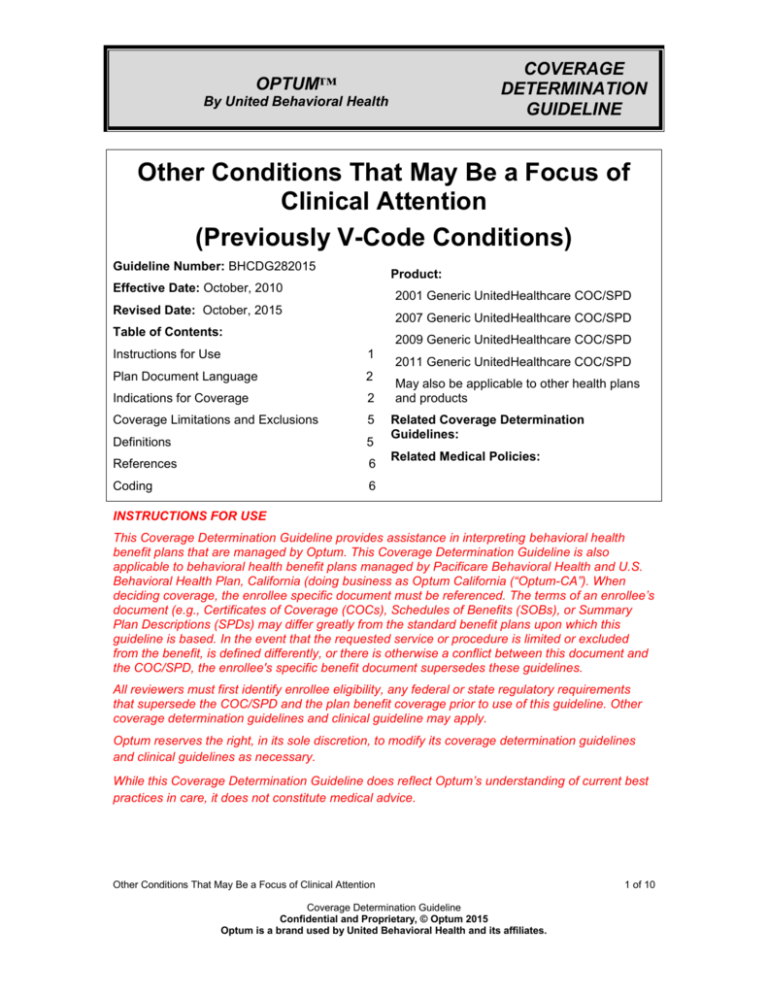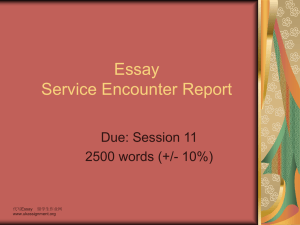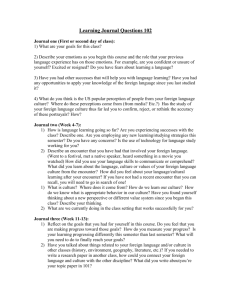
COVERAGE
DETERMINATION
GUIDELINE
OPTUM™
By United Behavioral Health
Other Conditions That May Be a Focus of
Clinical Attention
(Previously V-Code Conditions)
Guideline Number: BHCDG282015
Product:
Effective Date: October, 2010
2001 Generic UnitedHealthcare COC/SPD
Revised Date: October, 2015
2007 Generic UnitedHealthcare COC/SPD
Table of Contents:
2009 Generic UnitedHealthcare COC/SPD
Instructions for Use
1
Plan Document Language
2
Indications for Coverage
2
Coverage Limitations and Exclusions
5
Definitions
5
References
6
Coding
6
2011 Generic UnitedHealthcare COC/SPD
May also be applicable to other health plans
and products
Related Coverage Determination
Guidelines:
Related Medical Policies:
INSTRUCTIONS FOR USE
This Coverage Determination Guideline provides assistance in interpreting behavioral health
benefit plans that are managed by Optum. This Coverage Determination Guideline is also
applicable to behavioral health benefit plans managed by Pacificare Behavioral Health and U.S.
Behavioral Health Plan, California (doing business as Optum California (“Optum-CA”). When
deciding coverage, the enrollee specific document must be referenced. The terms of an enrollee’s
document (e.g., Certificates of Coverage (COCs), Schedules of Benefits (SOBs), or Summary
Plan Descriptions (SPDs) may differ greatly from the standard benefit plans upon which this
guideline is based. In the event that the requested service or procedure is limited or excluded
from the benefit, is defined differently, or there is otherwise a conflict between this document and
the COC/SPD, the enrollee's specific benefit document supersedes these guidelines.
All reviewers must first identify enrollee eligibility, any federal or state regulatory requirements
that supersede the COC/SPD and the plan benefit coverage prior to use of this guideline. Other
coverage determination guidelines and clinical guideline may apply.
Optum reserves the right, in its sole discretion, to modify its coverage determination guidelines
and clinical guidelines as necessary.
While this Coverage Determination Guideline does reflect Optum’s understanding of current best
practices in care, it does not constitute medical advice.
Other Conditions That May Be a Focus of Clinical Attention
Coverage Determination Guideline
Confidential and Proprietary, © Optum 2015
Optum is a brand used by United Behavioral Health and its affiliates.
1 of 10
Key Points
Other Conditions That May Be a Focus of Clinical Attention as primary diagnoses
defined in the current edition of the Diagnostic and Statistical Manual of the American
Psychiatric Association are excluded. Indications for coverage are limited to
circumstances where (Certificate of Coverage, 2001, 2007, 2009, 2011):
o
Other Conditions That May Be a Focus of Clinical Attention are a secondary
diagnosis; and
o
The primary diagnosis is a covered condition; and
o
Treatment is principally focused on the primary diagnosis.
According to the DSM, the diagnostic category Other Conditions That May Be a Focus of
Clinical Attention includes conditions and problems that may be a focus of clinical attention or
that may otherwise affect the diagnosis, course, prognosis, or treatment of a behavioral
health condition. Other Conditions That May Be a Focus of Clinical Attention are not
considered behavioral health diagnoses. They are meant to draw attention to additional
issues that may be encountered during treatment (Diagnostic and Statistical Manual of
Mental Disorders, 5th ed.; DSM-5; American Psychiatric Association, 2013).
A “primary diagnosis” (i.e., principal diagnosis) is defined as the condition that after a
complete evaluation is determined to be the chief cause for treatment and also becomes the
focus of treatment. When a person has multiple diagnoses, the first disorder listed is
assumed to be the primary diagnosis unless the provider otherwise spec (DSM-5, 2013).
Other Conditions That May Be a Focus of Clinical Attention are only covered as a “secondary
diagnosis,” (i.e., a diagnosis that is not the principal focus of treatment).
PART I: BENEFITS
Before using this guideline, please check enrollee’s specific plan document and
any federal or state mandates, if applicable.
Benefits
Benefits include the following services:
Diagnostic evaluation and assessment
Treatment planning
Referral services
Medication management
Individual, family, therapeutic group and provider-based case
management services
Crisis intervention
Covered Services
Covered Health Service(s) – 2001
Those health services provided for the purpose of preventing, diagnosing or
treating a sickness, injury, mental illness, substance abuse, or their
symptoms.
Other Conditions That May Be a Focus of Clinical Attention
2 of 10
A Covered Health Service is a health care service or supply described in
Section 1: What's Covered--Benefits as a Covered Health Service, which is
not excluded under Section 2: What's Not Covered--Exclusions.
Covered Health Service(s) – 2007 and 2009
Those health services, including services, supplies, or Pharmaceutical
Products, which we determine to be all of the following:
Provided for the purpose of preventing, diagnosing or treating a
sickness, injury, mental illness, substance abuse, or their symptoms.
Consistent with nationally recognized scientific evidence as available,
and prevailing medical standards and clinical guidelines as described
below.
Not provided for the convenience of the Covered Person, Physician,
facility or any other person.
Described in the Certificate of Coverage under Section 1: Covered
Health Services and in the Schedule of Benefits.
Not otherwise excluded in this Certificate of Coverage under Section 2:
Exclusions and Limitations.
In applying the above definition, "scientific evidence" and "prevailing medical
standards" shall have the following meanings:
"Scientific evidence" means the results of controlled clinical trials or
other studies published in peer-reviewed, medical literature generally
recognized by the relevant medical specialty community.
"Prevailing medical standards and clinical guidelines" means nationally
recognized professional standards of care including, but not limited to,
national consensus statements, nationally recognized clinical
guidelines, and national specialty society guidelines.
Pre-Service Notification
Admissions to an inpatient, residential treatment center, or a partial hospital/day
treatment program require pre-service notification. Notification of a scheduled
admission must occur at least five (5) business days before admission.
Notification of an unscheduled admission (including Emergency admissions)
should occur as soon as is reasonably possible. Benefits may be reduced if
Optum is not notified of an admission to these levels of care. Check the
member’s specific benefit plan document for the applicable penalty and provision
for a grace period before applying a penalty for failure to notify Optum as
required.
Limitations and Exclusions
Other Conditions That May Be a Focus of Clinical Attention – 2001, 2007,
2009 & 2011
Other Conditions That May Be a Focus of Clinical Attention
3 of 10
Mental health treatments for Other Conditions That May Be a Focus of Clinical
Attention as listed in the current edition of the Diagnostic and Statistical Manual
of the American Psychiatric Association which, according to the DSM, are not
attributable to a mental health disorder or disease are excluded.
Additional Information: The lack of a specific exclusion of a service does not
imply that the service is covered.
The following are examples of circumstances under which mental health
treatments for Other Conditions That May be the Focus of Clinical Attentions (Vcode condition) are excluded (not an all inclusive list).
The problem is the focus of diagnosis or treatment and individual has no
behavioral health condition (e.g., a Partner Relational Problem in which
neither partner has symptoms that meet criteria for a behavioral health
condition).
The individual has a behavioral health condition but it is unrelated to the
presenting problem (e.g., a Partner Relational Problem in which one of the
partners has an incidental behavioral health condition), and the problem –
not the behavioral health condition – is the focus of diagnosis or treatment.
DEFINITIONS
Other Conditions That May Be a Focus of Clinical Attention Conditions and
problems that may be a focus of clinical attention or that may otherwise affect the
diagnosis, course, prognosis, or treatment of a behavioral health condition. Other
Conditions That May Be a Focus of Clinical Attention are not considered
behavioral health conditions. They are meant to draw attention to additional
issues that may be encountered during treatment.
REFERENCES
1. Generic UnitedHealthcare Certificate of Coverage, 2001
2. Generic UnitedHealthcare Certificate of Coverage, 2007
3. Generic UnitedHealthcare Certificate of Coverage, 2009
4. Generic UnitedHealthcare Certificate of Coverage, 2011
5. Diagnostic and Statistical Manual of the American Psychiatric Association,
Fifth Edition, 2013.
CODING
The Current Procedural Terminology (CPT) codes and HCPCS codes listed in this guideline are
for reference purposes only. Listing of a service code in this guideline does not imply that the
service described by this code is a covered or non-covered health service. Coverage is
determined by the benefit document.
Limited to specific CPT and HCPCS codes?
Other Conditions That May Be a Focus of Clinical Attention
□
YES
x
NO
4 of 10
DSM-5 Codes
V15.41
ICD-9 Codes
Z62.810
V15.42
Z62.811
V15.49
Z91.49
V15.59
V15.81
Z91.5
Z91.19
V15.89
V40.31
Z91.89
Z91.83
V60.0
V60.1
V60.2
Z59.0
Z59.1
Z59.5
V60.3
V60.6
Z60.2
Z59.3
V60.89
Z64.4
V60.9
Z59.9
V61.03
Z63.5
V61.10
Z63.0
V61.11
Z69.11
V61.12
Z69.12
Other Conditions That May Be a Focus of Clinical Attention
Applicable Diagnoses
Personal History (Past History) of
(Physical Abuse in
Childhood)
(Sexual Abuse in
Childhood)
(Spouse or Partner
Violence, Physical) (Spouse
or Partner Violence,
Sexual)
Personal History (Past History) of
(Neglect in Childhood)
(Psychological Abuse in
Childhood)
(Spouse or Partner Neglect)
(Spouse or Partner
Psychological Abuse)
Other Personal History of
Psychological Trauma
Personal History of Self-Harm
Non-adherence to Medical
Treatment
Other Personal Risk Factors
Wandering Associated with a
Mental Disorder
Homelessness
Inadequate Housing
Extreme Poverty
Insufficient Social Insurance or
Welfare Support
Lack of Adequate Food or Safe
Drinking Water
Low Income
Problem Related to Living Alone
Problem Related to Living In a
Residential Institution
Discord with Neighbor, Lodger, or
Landlord
Unspecified Housing or Economic
Problem
Disruption of Family by Separation
or Divorce
Relationship Distress with Spouse
or Intimate Partner
Encounter for Mental Health
Services for Victim of Spouse or
Partner
(Neglect)
(Psychological Abuse)
(Violence, Physical)
(Violence, Sexual)
Encounter for Mental Health
Services for Perpetrator of Spouse
or Partner
(Neglect)
5 of 10
V61.20
V61.21
Z62.820
Z69.010
V61.22
Z69.011
V61.29
Z62.898
V61.5
V61.7
Z64.1
Z64.0
V61.8
Z63.8
V62.21
N94.3
V62.22
Z65.5
V62.29
Z56.82
V62.3
V62.4
Z55.9
Z60.3
V62.5
Z65.0
V62.82
V62.83
Z63.4
Z69.021
Other Conditions That May Be a Focus of Clinical Attention
(Psychological Abuse)
(Violence, Physical)
(Violence, Sexual)
Parent-Child Relational Problem
Encounter for Mental Health
Services for Victim of
(Child Abuse by Parent)
(Child Neglect by Parent)
(Child Psychological Abuse
by Parent)
(Child Sexual Abuse by
Parent)
(Nonparental Child Abuse)
(Nonparental Child Neglect)
(Nonparental Child
Psychological Abuse)
(Nonparental Child Sexual
Abuse)
Encounter for Mental Health
Services for Perpetrator of Parental
(Child Abuse)
(Child Neglect)
(Child Psychological Abuse)
(Child Sexual Abuse)
Child Affected by Parental
Relationship Distress
Problems Related to Multiparity
Problems Related to Unwanted
Pregnancy
High Expressed Emotion Level
within Family
Sibling Relational Problem
Upbringing Away from Parent
Problem Related to Current Military
Deployment Status
Exposure to Disaster, War, or Other
Hostilities
Personal History of Military
Deployment
Other Problem Related to
Deployment
Academic or Educational Problem
Acculturation Difficulty
Social Exclusion or Rejection
Target of (Perceived) Adverse
Discrimination or Persecution
Conviction in Civil or Criminal
Proceedings without Imprisonment
Imprisonment or Other Incarceration
Problems Related to Other Legal
Circumstances
Problems Related to Release from
Prison
Uncomplicated Bereavement
Encounter for Mental Health
6 of 10
V62.89
R41.83
V62.9
Z60.9
V63.8
Z75.4
V63.9
Z75.3
V65.2
V65.40
V65.49
Z76.5
Z71.9
Z69.81
V69.9
V71.01
V71.02
Z72.9
Z72.11
Z72.810
278.00
995.51
E66.9
T74.32XA; T74.32XD
995.52
T74.02XA; T74.02XD
Other Conditions That May Be a Focus of Clinical Attention
Services for Perpetrator of
(Nonparental Child Abuse)
(Nonparental Child Neglect)
(Nonparental Child
Psychological Abuse)
(Nonparental Child Sexual
Abuse)
(Nonspousal Adult Abuse)
Borderline Intellectual Functioning
Discord with Social Service
Provider, Including Probation
Officer, Case Manager, or Social
Services Worker
Other Problems Related to
Psychosocial Circumstances
Phase of Life Problem
Religious or Spiritual Problem
Victim of Crime
Victim of Terrorism or Torture
Unspecified Problem Related to
Social Environment
Unspecified Psychological
Circumstances
Unavailability or Inaccessibility of
Other Helping Agencies
Unavailability of Inaccessibility of
Health Care Facilities
Malingering
Other Counseling or Consultation
Encounter for Mental Health
Services for Victim of Nonspousal
Abuse Abuse
Sex Counseling
Problem Related to Lifestyle
Adult Antisocial Behavior
Child or Adolescent Antisocial
Behavior
Overweight or Obesity
Child Psychological Abuse,
(Confirmed, Initial
Encounter)
(Confirmed, Subsequent
Encounter)
(Suspected, Initial
Encounter)
(Suspected, Subsequent
Encounter)
Child Neglect
(Confirmed, Initial
Encounter)
(Confirmed, Subsequent
Encounter)
(Suspected, Initial
Encounter)
(Suspected, Subsequent
7 of 10
995.53
T74.22XA; T74.22XD
995.54
T74.12XA; T74.12XD
995.81
T74.11XA; T74.11XD
995.82
T74.31XA; T74.31XD
Other Conditions That May Be a Focus of Clinical Attention
Encounter)
Child Sexual Abuse
(Confirmed, Initial
Encounter)
(Confirmed, Subsequent
Encounter)
(Suspected, Initial
Encounter)
(Suspected, Subsequent
Encounter)
Child Physical Abuse
(Confirmed, Initial
Encounter)
(Confirmed, Subsequent
Encounter)
(Suspected, Initial
Encounter)
(Suspected, Subsequent
Encounter)
Adult Physical Abuse by Nonspouse
or Nonpartner
(Confirmed, Initial
Encounter)
(Confirmed, Subsequent
Encounter)
(Suspected, Initial
Encounter)
(Suspected, Subsequent
Encounter)
Spouse or Partner Violence,
Physical
(Confirmed, Initial
Encounter)
(Confirmed, Subsequent
Encounter)
(Suspected, Initial
Encounter)
(Suspected, Subsequent
Encounter)
Adult Psychological Abuse by
Nonspouse or Nonpartner
(Confirmed, Initial
Encounter)
(Confirmed, Subsequent
Encounter)
(Suspected, Initial
Encounter)
(Suspected, Subsequent
Encounter)
Spouse or Partner Abuse,
Psychological,
(Confirmed, Initial
Encounter)
(Confirmed, Subsequent
Encounter)
(Suspected, Initial
8 of 10
995.83
T74.21XA; T74.21XD
995.85
T74.01XA; T74.01XD
Encounter)
(Suspected, Subsequent
Encounter)
Adult Sexual Abuse by Nonspouse
or Nonpartner
(Confirmed, Initial
Encounter)
(Confirmed, Subsequent
Encounter)
(Suspected, Initial
Encounter)
(Suspected, Subsequent
Encounter)
Spouse or Partner Violence,
Sexual,
(Confirmed, Initial
Encounter)
(Confirmed, Subsequent
Encounter)
(Suspected, Initial
Encounter)
(Suspected, Subsequent
Encounter)
Spouse or Partner Neglect,
(Confirmed, Initial
Encounter)
(Confirmed, Subsequent
Encounter)
(Suspected, Initial
Encounter)
(Suspected, Subsequent
Encounter)
Limited to place of service (POS)?
□
x
NO
Limited to specific provider type?
□ YES x
NO
Limited to specific revenue codes?
□
NO
YES
YES
x
HISTORY
Revision Date
5/2012
9/2013
10/2014
10/2015
Name
L. Urban
L. Urban
G. Niewenhous
L. Urban
Revision Notes
Version 1-Final
Version 2-Final
Version 3-Final
Version 4-Final
The enrollee's specific benefit documents supersede these guidelines and are used to make coverage determinations.
Other Conditions That May Be a Focus of Clinical Attention
9 of 10
These Coverage Determination Guidelines are believed to be current as of the date noted.
Other Conditions That May Be a Focus of Clinical Attention
10 of 10







